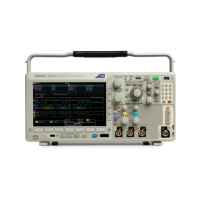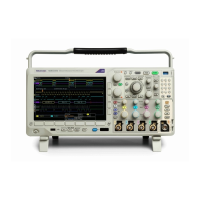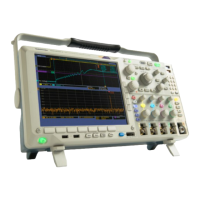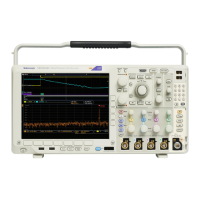Command Groups
When the two man
ual markers are turned on, the Reference Marker is no longer
automatically attached to the highest amplitude peak. It can now be moved toany
desired location. This enables easy measurement of any part of the spectrum,
as well as delta measurements to any part of the spectrum. This also lets you
measure non-peak spectral content of interest. The readouts for manual markers
indicate frequency, amplitude and noise (just like automatic marker readouts).
Taking Auto
matic
Measurements in the
Frequency Domain
You can take three automatic measurements in the frequency domain:
1. Channel Power (CP) — The total power within the bandwidth, defined by
the Channel Width.
2. Adjacent Channel Power Ratio (ACPR) — The power in the main channel
and the ratio of channel power to main power, for the upper and lower halves of
each adjacent channel.
3. Occupied Bandwidth (OBW) — The bandwidth that contains the specified
percentage of power within the analysis bandwidth.
Triggering using RF
Power L evel as a Source;
Searching
The ability to use the RF power level as the source for edge triggering and
searching is provided standard with the MDO4000/B and MDO4000C with
option SA3 or SA6 series models. With the MDO4TRIG (Advanced Trigger)
application module installed, the RF power level can also be used as the source
for p
ulse width, time-out, runt, logic, and sequence triggering. (See page 2-76,
Trigger Command Group.) A number of search commands are also available.
(See page 2-61, Search Command Group.)
Transfe rring and Saving
RF Trace Information
Yo
u can perform waveform transfer commands and queries using RF traces. (See
page 2-95, Waveform Transfer Command Group.)
RF
traces can be saved to an .ISF or .CSV file for subsequent recall to any of the
4 internal reference memory locations. The oscilloscope can also save, butnot
recall, RF acquisitions as .TIQ files. You can import .TIQ files into Tektronix
SignalVu-PC software (PC based), SignalVu software (oscilloscope based),
RSAVu software (PC based) or into a Tektronix real-time spectrum analyzer for
pulse analysis and demodulation analysis. (See page 2-58, Save and Recall
Command Group.)
NOTE. The RF input replaces the Aux Input connector on the front panel,
therefore aux-in commands and arguments are not supported on the MDO4000/B,
MDO4000C with option SA3 or SA6, and MDO3000 models with 4-channels.
MDO4000/B/C, MSO/DPO4000B and MDO3000 Series Oscilloscopes Programmer Manual 2-51

